
The mixed-grass prairie once covered a greater portion of the Mississippi River basin, spanning the valley’s western uplands to the foothills of the Rocky Mountains. Untilled and unirrigated by its indigenous population, it formed the primeval grassland ecology of the American Midwest. To mid-nineteenth-century settlers, the prairie occupied the vast and unexplored interior of the continent. Their early encounters with its unfamiliar qualities were lent to sweeping characterizations: an inhospitable, treeless desert as well as a mythic garden where “Rain Follows the Plow.”1 Contradictory formulations such as these mirrored the nascent cultural and technological narratives of westward expansion, themes that described an environment meant to be confronted rather than endured.
As these narratives coalesced into policy and infrastructure, interactions with the landscape provoked unique social and architectural forms. Migrants, traveling west to claim land under the Homestead Act, became agents of its transformation, supplying the necessary labor while channeling prevailing notions of western life. Their efforts soon engendered a rich material culture rooted firmly in the problems posed by the new environment—coping with scarcity, distance, and frequent extreme weather conditions. And as their circumstances refined—and often refuted—the national ideals of an agrarian utopia, an edenic recovery, and Jeffersonian individualism, the recording of history and the production of representative images formed an important venue for articulating the changing conceptions of the frontier.
In this feedback of changing environments and changing representations, often subtle and often abstracted to territorial scales, the photography of Solomon D. Butcher and his subject matter of the sod house provide a concrete moment for critical review. Extremely specific in time and place, Butcher’s work documents the early history of Custer County, Nebraska, and the brief heyday of the North American sod house, the dwelling of choice for the leading wave of prairie settlers. This method of construction was closely tied to the affordances of the landscape and attendant to ongoing transformations in the nation’s infrastructure. Most importantly, however, the sod house was a home, and in circumstances so far removed from popular conceptions of architecture, indeterminate in its social representation. It was thereby free to be rendered into life by Butcher’s camera and historicize the early days of pioneer settlement. To this end, his images exhibit an array of representational instruments, conventions evoking and suggesting the peculiarity of the Nebraska prairie.2 Binding media so closely to its content’s specificity, they allow an understanding of the images in relation to particular environmental–historical events, situating Butcher’s often unusual photographic practices within the context of the western landscape image.
The personal stories his photographs recounted, the know-how they conveyed, and the specific moments they captured are inseparable from the legislative and economic frameworks that circumscribed them. Butcher’s subject matter represented the palpable consequences of otherwise abstract decisions, describing the local actions that, in aggregate, advanced a national program. Against the backdrop of the Homestead Acts, emerging local governments, the expansion of the railroad network, and the commodification of public lands, migrants populated the Midwest. They built homes, towns, and cultures, all while tilling the prairies into farmland. The sod houses and Butcher’s photographs were part and parcel of this process—an ongoing construction of a built environment—and worked to mediate the tensions between local and national, material and representational that ultimately guided the region’s transformation.
Solomon Butcher’s journey to the prairie told a familiar story to the homesteaders in Custer County and the region at large. His wagon trip west, his adventures in filing a claim, and his construction of a shelter had a counterpart in every pioneer’s narrative, allowing his photographs to give specificity to a broadly shared experience.3 An early image shows Butcher standing at the entrance to his dugout, a sod-walled room partially built into the earth. It depicts a slumping structure rising from surrounding waist-height grass, a caption scratched in reverse on the negative noting: “My first house in Neb. 1880 built from ‘Neb. Brick.’”4 Butcher’s experience in the following years familiarized him with the homesteader lifestyle, and the intimate knowledge of the area and its inhabitants formed an important starting point for the documentary project he would later pursue.
Guided by the grid defined in the Land Ordinance of 1785—which divided the territory of the United States frontier into standardized plots—the Homestead Act of 1862 incentivized migration into the West, granting male and female settlers a claim of one quarter-section (a quarter-mile square, or 160 acres) of “unappropriated public lands.”5 In concert with exclusionary policies and the violent displacement of Native Americans, the act set the stage for the US settlement of the region by citizens and naturalized immigrants. The charge of the law can be traced to notions of the Jeffersonian “yeoman farmer,” by which it engaged in an ongoing debate about political economy, specifically surrounding abolition and land ownership. Though enacted after the secession of southern states and most significantly put into practice following the American Civil War, the legislation had been closely tied to efforts in establishing the West as “free soil” at a time when the expansion of slavery had been the primary site of political contention. Definitions of sovereignty and ownership were also implicated in the act’s conception: supporters of homesteading legislation subscribed to the “labor theory of property,” a widespread idea at the time that understood appropriation as a function of realized labor.6 For the Homestead Act, this was articulated in the requirement that grantees reside in and “improve” the land for five years. Built into the legal provisions of western expansion, as well as its conceptual foundations, was a program for the wholesale transformation of a landscape.
Central to this history, it was the lack of trees in the prairie that made sod construction a necessity. This deficiency had been prominently noted by early white travelers in the region, who understood it as a sign that the landscape was barren and uninhabitable.7 But as settlement of the area intensified, sod bricks, harvested from the thick root systems of undisturbed prairie grass, became the ubiquitous building material supporting the region’s inhabitation. In addition to homes and the occasional public building, this “Prairie Marble” could serve as fencing for animal pens, walls for storage structures, and even landmarks, with cross-shaped incisions into the sod denoting the surveyed corners of the Land Ordinance grid.8 More generally, in the years between the first settlers’ arrival to the prairie and the sufficient expansion of the railroad network, the availability of common building materials was severely limited.9 The sod house, consequently, had a moment between 1872 and 1890, the formative years of frontier infrastructure.
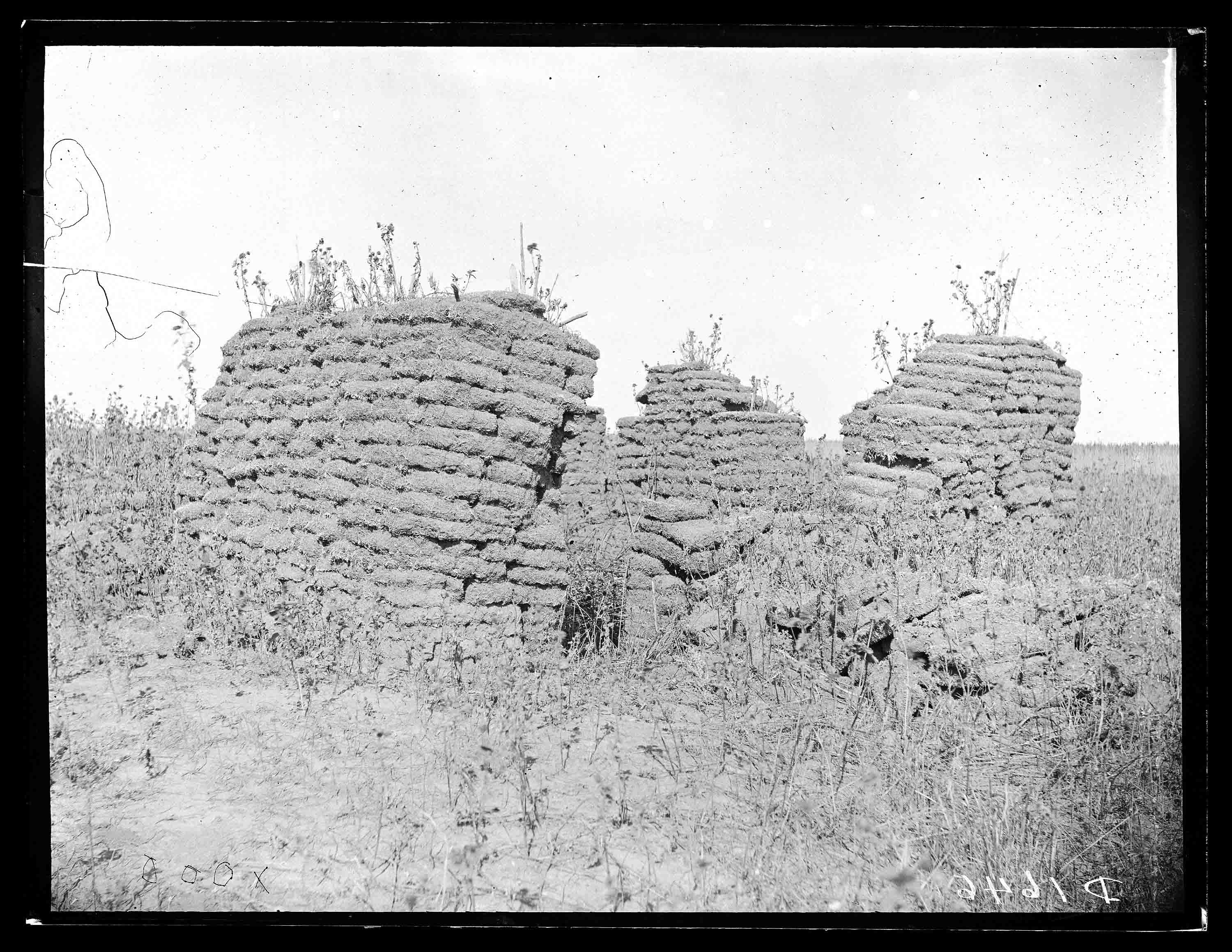
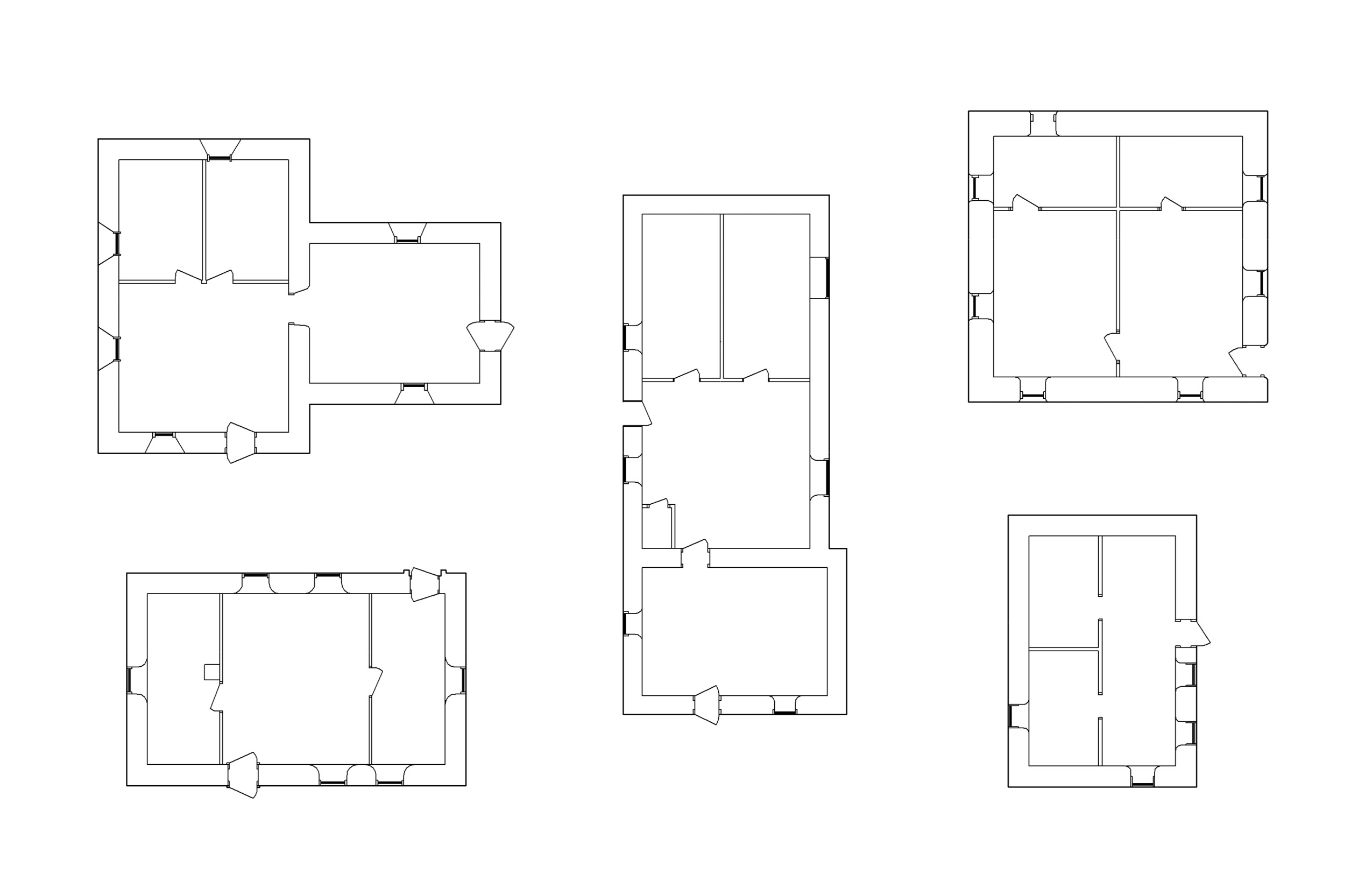
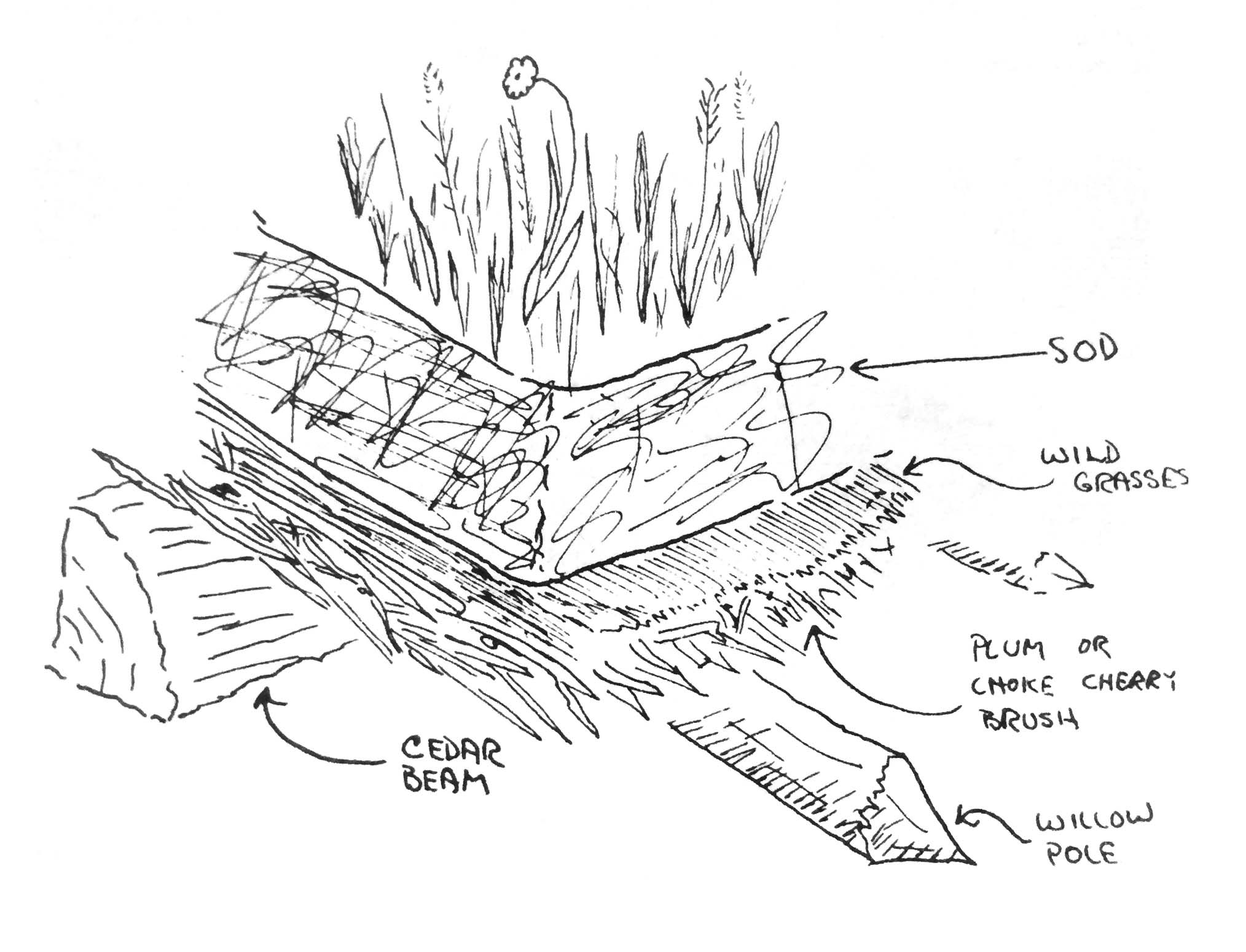
Butcher’s project was carried out toward the end of this period. Setting out to create the first history of Custer County, he proposed a photo album detailing its homesteads and pioneer settlers. Starting in 1886, he packed up a “photo wagon” and spent the next seven years traversing the region, covering the county’s 2,576 square miles and taking over 1,500 “farmviews,” which, in total, documented one-third of the resident settler population.10 Sources agree that this was not a sustainable enterprise for Butcher: his progress was slow, constantly interrupted by financial setbacks and mounting debt.11 And though Butcher stayed remarkably productive during difficult circumstances, his practice ultimately failed to finance the publication of the work.
On a morning in 1899, tragedy struck when a barn fire destroyed the manuscripts Butcher had assembled over his travels. The negatives, stored elsewhere, survived, but the project’s photo album format—a collection of single images accompanied by biographical texts—was no longer a possibility. Redoubling his efforts, he found a benefactor in one of the early settlers and gathered materials for the revised publication, this time more closely adhering to the tradition of “Pioneer History” books common to the era.12 The completed Pioneer History of Custer County was published in 1901 and was in many ways a far cry from his original vision. Despite his exhaustive surveying, only eighteen sod house photographs made it into the book, serving as occasional illustrations to written accounts rather than the work’s primary content.
But the archive of photographs remained intact.13 As a body of work, it represents an incredibly comprehensive record of the prairie’s population and landscape—and the only significant reference for the sod houses.14 The collection describes a period during which material scarcity was accompanied by a similar dearth of communication with industrialized America, including its central institutions, a time during which pioneers were tasked with determining their own cultural background and recording their own history. The value of a project such as Butcher’s, then, is its connection of an emerging representational form with changing social and environmental circumstances. A specific set of photographic standards captured the variety of possible elaborations of the homestead claim and sod house. These were animated by recurring representational devices that Butcher tailored to the situation, mediating the demands of his itinerant practice, the subject matter, and his historical project.
Butcher’s prototypical format was, to a large extent, determined by the problem of framing his subjects in relation to their environment. In the farmviews, the scene hovers around the sod house and renders it a prominent feature of the landscape, its residents defined by their position amid the material sprawl of the homestead. The focus on this kind of domestic scale places Butcher’s photographs in a space between the studio portraiture practiced by his mid-western peers and the heroic compositions of his contemporary landscape photographers.15 Though the sod houses’ inhabitants were undeniably the subject, they would be incomplete without the wider view of their surroundings, the tangible product of their labor and migration.

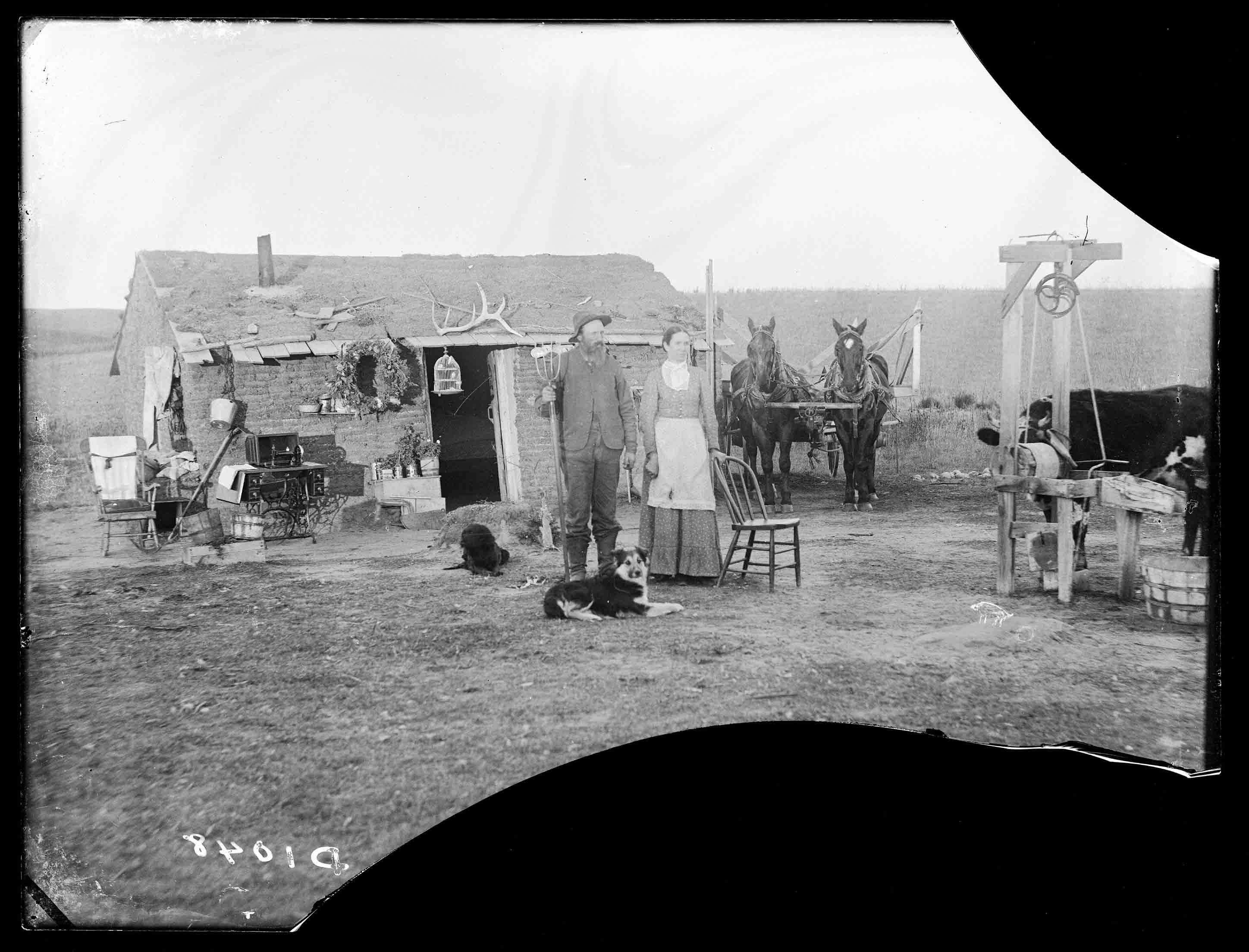
Unlike the survey photographers, who aestheticized western lands as sites representative of a natural history, Butcher focused strictly on the built rather than “original” conditions of the landscape. As a pioneer, and thus so removed from the centers of political power, he had no institutional support to define a program or provide resources. The scientific ambitions that accompanied the survey expeditions did not register in his work, nor did their procedural rigor or technical sophistication. Instead Butcher’s photos developed a set of conventions drawn from the exigencies of life on the frontier. In depicting the homesteads as they confronted this landscape, the photos can be considered images of “events” rather than people or properties.16 Further, as a series of events, they specifically treat changes to the land—accumulated to a regional environmental transformation—as the primary cultural force in the life of the homesteaders.
The compositional decisions were also overtly linked to Butcher’s stated project of the farmviews forming a historical record.17 Broadly speaking, his photos depicted an expanded view of the sod houses, showing a foreground of residents and their effects, a deep middle ground of the house, and almost nothing in the distance. Butcher’s framing adjusted to the state of the homestead’s development: his photographs of new, unimproved farms were more tightly focused on the home and inhabitants, while wider views of more established homesteads put greater emphasis on the areas surrounding the house, revealing an intricate complex of additions, expansions, farm structures, and productive landscape features.18
The homestead’s furnishings were articulated to support the primacy of land ownership as an extension of its inhabitation, and Butcher went to great lengths to represent residents’ domestic belongings beside the farm’s improvements and agricultural implements. The staging of the farmviews could range from a foregrounded lineup of the residents to more articulate compositions of family members, wagons, tools, and animals among barns, windmills, wells, and plantings. Invariably, the images depicted an “inhabited,” working landscape, the site of a prairie life impossible to extricate from the outdoors. Generally, not much suggests that the interior of a sod house could be understood as a refuge from the elements: it was dim, usually drafty, constantly leaking, and often invited rodents and snakes.19 Butcher’s images accepted this fact and assimilated it into the historical narrative. With its inhabitants and interior contents emptied out into the frame, the house itself was able to be comprehensively described, and no evidence of the homesteaders’ labor left out of the view. Additionally, the variety of frontier ornaments that fill the space in front of the house show the residents deeply implicated in the act of taking a photograph. Their self-awareness, like Butcher’s exercise of compositional direction, wasn’t intended to dissemble. Rather, it demonstrated an intention in determining how the homesteaders would be represented—to themselves and ultimately to the world at large.
When elaborating this historical record, the breadth of Butcher’s photography also extended beyond scenes that could be readily photographed. Faithful to his subjects’ narratives, the limitations of the medium occasionally pushed him toward a set of eccentric measures—photo manipulations that attempted to capture fleeting phenomena or scenes that his camera hadn’t witnessed. These could be reenactments of past events, negatives edited to modify the content of the image, or a combination of the two.
Photo manipulation as we know it today was not an unusual practice among photographers in the nineteenth century, but unlike the painterly or methodological impulses behind most editing practices of the time, Butcher’s were aimed solely toward narrative ends.20 Though they were relatively few in the farmviews, such manipulated photos were thoroughly represented in the published Pioneer History, where they accompanied several firsthand accounts. The reconstructions would include well-known events such as the exploits of a famous cowboy or a dispute between homesteaders and ranchers, while among the more common “touch-ups” were creeks, birds, rabbits, plants, clouds of smoke, and gunshots.21
Duplicity was clearly not Butcher’s goal—his illustrations were “amateurish” and easily identified among the range of images—but his photo manipulations reveal a need not only to visually depict but to encompass within the bounds of photography the entirety of the county’s history.22 The privileged position accorded to the medium becomes clear in this case, elevated by its capacity to create objects of historical value on a localized, individual basis. Photography offered a power to describe the history of a society without robust social institutions—an undeniable record of the obstacles travailed by the Custer County pioneers.
Just as the historical value of the domestic scenes must be understood relative to Butcher’s process, the value of these manipulated images should be seen in the specific context of frontier photography. Far from our contemporary understanding of images operating within networks of media, Butcher’s photos lived much more closely to their subjects, with the vast majority of his archive unpublished and prints made only for homesteaders as the photographs were taken. His work predated the notion of documentary photography, carried out at a time when the conventions of the medium were open-ended and open to interpretation.23 The question of what photographic technology could and could not do was an open one, as were any deliberations about what was appropriate for use as an indexical artifact. Butcher’s interventions, in this sense, can be seen as attempts to explore its representational breadth, searching for ways to expand the medium.
As Butcher carried out his project, the landscape he photographed began to transform. The first train arrived in Broken Bow, the county seat, in 1886, bringing with it the telegraph and signaling significant changes to the area’s economy.24 By the end of the decade, the sod house remained a common feature of the landscape, but it was no longer the only viable method of architectural construction. The end of its ubiquity can be traced to a few factors that promoted timber frame construction but can be more broadly understood in parallel with the end of the homestead era.25


As regional shipping networks expanded, lumber prices fell and standard building materials became more readily available.26 At a more local scale, the Timber Culture Act of 1874, which had granted homesteaders an additional quarter section devoted to timber cultivation, began its first harvests.27 The houses themselves had also aged, and their usual lifetime of six to seven years now warranted a replacement rather than a renovation.28 Additionally, the majority of homesteaders on the prairie did not stay to fulfill their claim requirement, and of those that did, many were heavily mortgaged and eventually forced out by adverse conditions.29
With this, the protagonists of Butcher’s history also changed, and the practices and spatial configurations of industrial agriculture replaced the small-scale farms of the early homesteaders. The failure of the Homestead Act to manifest its original ideals became evident by the end of the century, the accumulation of capital that it ultimately enabled functioning to consolidate individual properties. Provisions to restrain land speculation had been a contested issue during the act’s conception but by its passage had been forfeited to partisan interests, later inviting massive commercial land-grabs.30 The 160-acre scale of the homestead also proved a burden when, enabled by a density of shipping networks, it incentivized the production of commodity crops over subsistence farming, alienating the production of the small-scale farmers and binding them to networks of agricultural finance.31 What’s more, the transformation of the landscape and the period’s influx of settlers had dispossessed the majority of the prairie’s indigenous inhabitants.
In all, by the time the Pioneer History was published in 1901, the subjects Butcher had originally sought to document, who were also the stated audience of the work, no longer existed.32 The Jeffersonian yeoman had been replaced by the tenant farmer, and the homestead, now nominally “improved,” welcomed investment bringing mechanization and relief from immediate precarity.
Although the region’s eventual transformation can suggest an image of coordinated intervention, westward expansion was overseen by widely disparate political interests, and its results were ultimately tied to the material realities of the western landscape, to its capacity as the soon-to-be built environment of agricultural production.33 The homesteaders personally assayed this capacity, pushing west in increments and fragments within the framework of the Land Ordinance grid, turning the soil one section at a time.
In the preface of the Pioneer History of Custer County, Butcher poses a seemingly defensive question to the reader. In it, he describes the true agent of his frontier history, outlining a contract between the homesteader and the historical record at large:
If, in looking over the pages of this book, you find a fuller description of some other portion of the county than your own, pause before criticizing the historian and ask if it is not your own fault that you are not more fully represented. If you have done any great deeds in Custer county which are worthy to go down in history, was it not your duty to have them recorded?34
So much of Butcher’s project can be extrapolated from this premise: his impulse to localize, treating the county as a series of discrete sites; his emphasis on individual events instead of overarching histories; his understanding of narrative as an act of invention; as well as a deep-rooted basis for his itinerant practice, one that actively sought out these histories. His work describes the priorities of a cultural context in which surviving the winter was a greater enterprise than living up to national ideals and in which political representation really could be ensured on individual terms, in a fundamentally transparent, if heavily mediated, format. The published book was itself explicit about the residents’ contributions, but Butcher had solicited narratives from residents all through the project, never affecting that he would be the one writing the history.35 The absence of an institution broader than the individual to legitimize the record also decouples it from the immediacy of parallel events, assuming a necessarily incomplete description of the past, and more importantly, one emphatic about its fragmentary, rather than totalizing, scope.
In this way, such a representation formed a political representation. The farmviews articulated a subjectivity central to the historical development of the American West yet anonymized by the collective outcome of their efforts—the space and experience of individual homesteaders upon whom the tasks of transforming their immediate environment fell.36
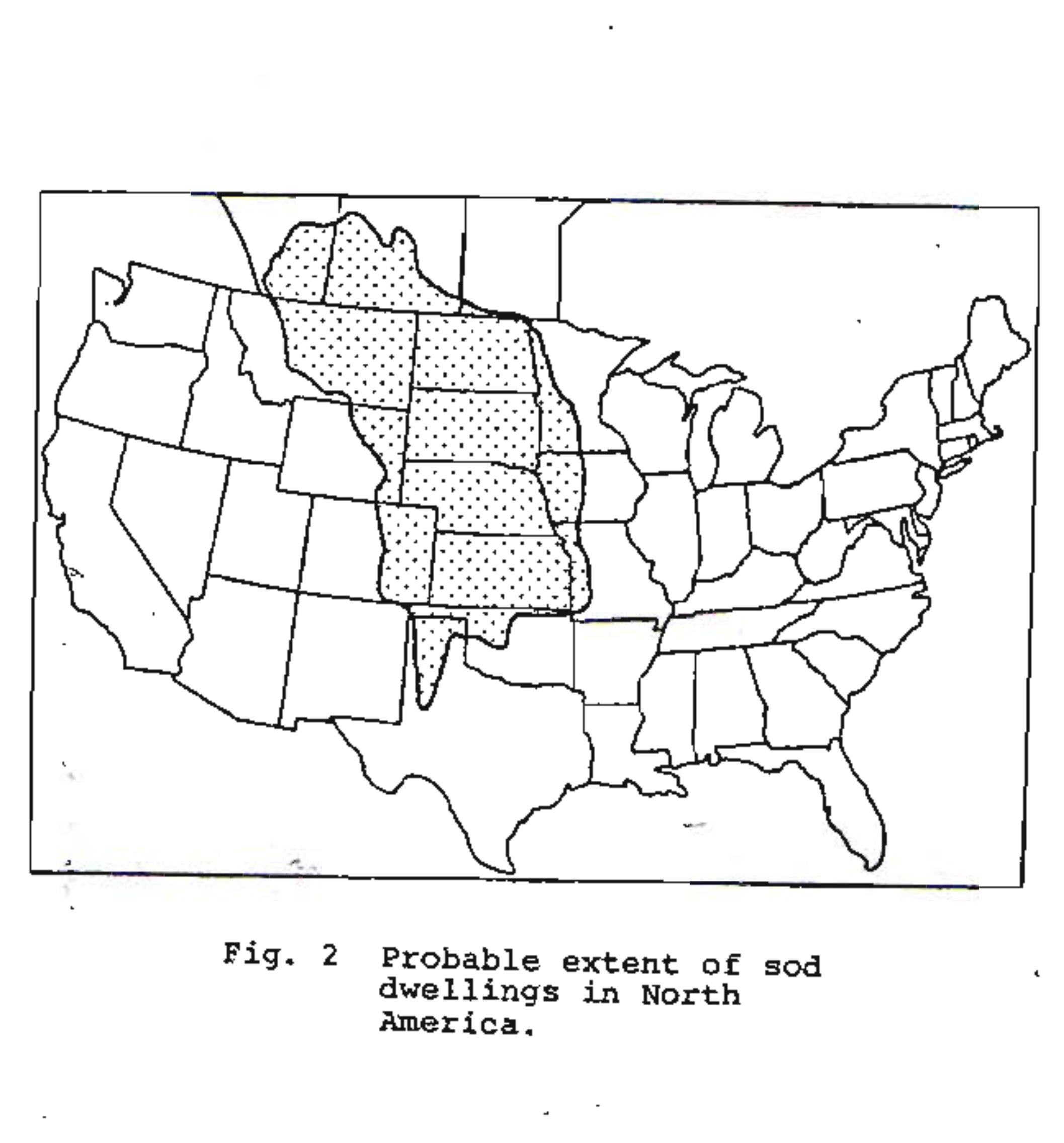
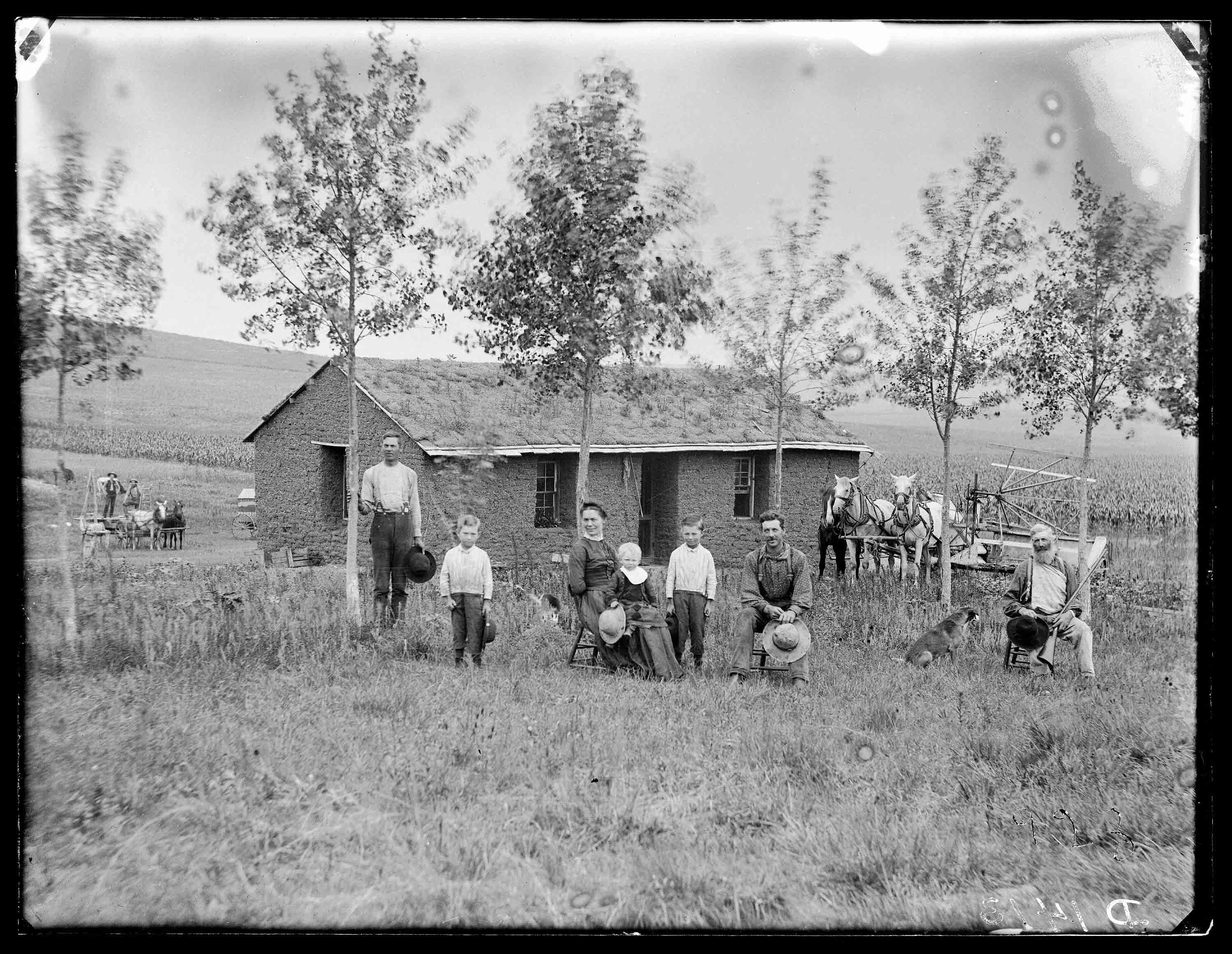
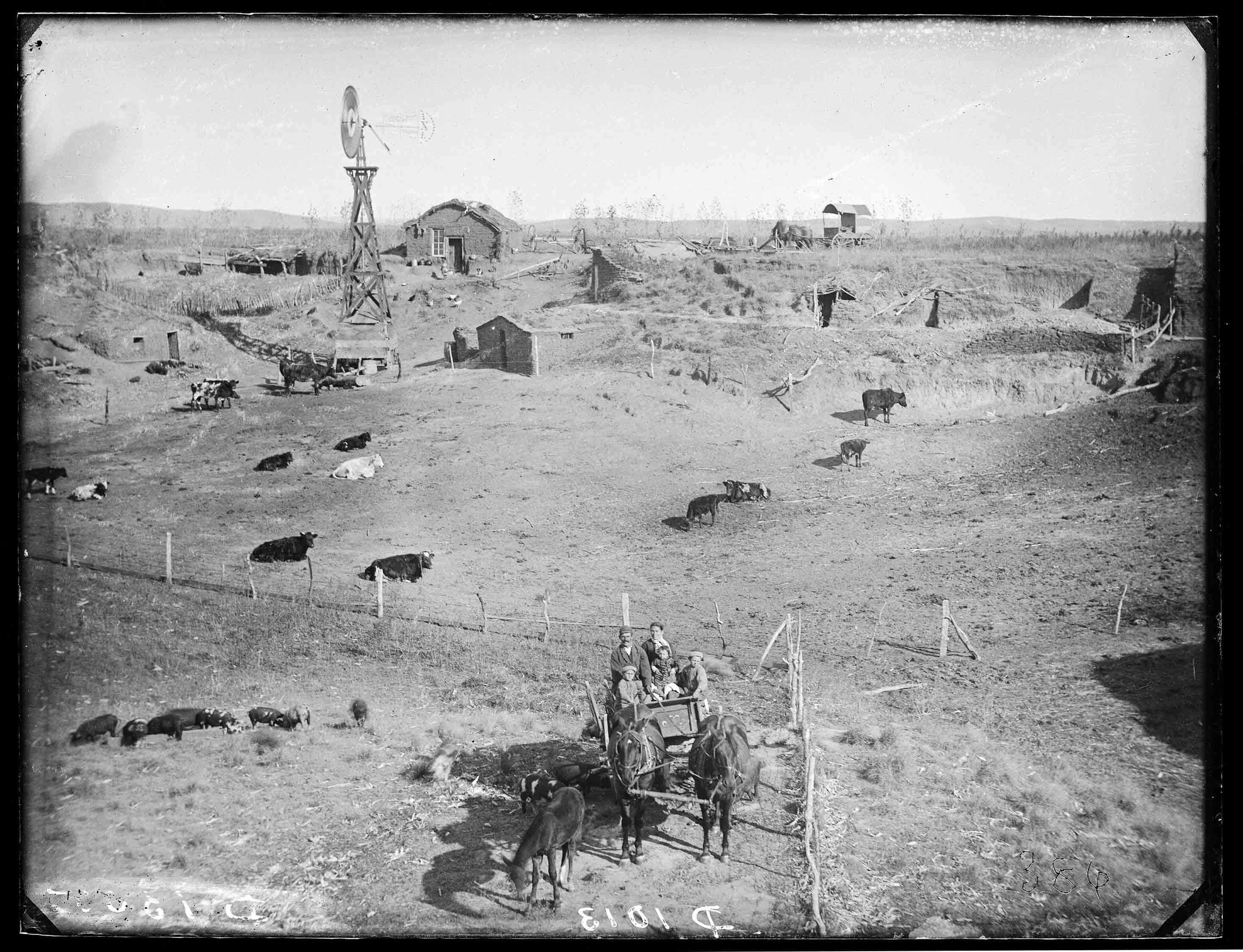
By engaging directly with the methods and demands of documentation, Butcher’s photographs addressed a distinctly architectural problem posed by the acculturation of new imaging technologies. While they are not architectural representations in an instrumental sense, they nonetheless possess an agency when considered in a disciplinary context. They sought to capture an event that had never happened before, beyond the descriptive reach of contemporary photographic techniques, and so required a new set of norms, new representational conventions. In elaborating a still-indeterminate medium, the Butcher collection describes the conditions under which new modes of spatial representation emerge and their attenuation to the environments and subjects that they represent.
Taken broadly, toward the ends of describing an architecture: Butcher developed his own photographic standards, expanded their content to include far-reaching environmental narratives, and captured the social relations in which the architecture existed. He determined what would be represented and how, establishing the bounds of the archive and the procedures for its compilation.37 This consisted of formal techniques of staging, composition, modification, and annotation but also extended to the attribution of a truth value to the images and their assembly into a coherent body of work. Though the affordances of the photographic medium are inescapable when considering his project, the images were no more technologically determined than their content. Although made possible by a range of interrelated innovations, they were propelled by a specific, situated idea of photography rather than any abstract notions about its use as a technology.
The Custer County images offer a particularly clear example of this process, but at the present moment—in which the diffuse networks that support the ongoing production of the built environment become ever more entwined with the modes of their representation—the capacity of architecture to internalize the dynamics by which media technologies emerge has become an urgent demand. Articulated by architects in terms of mappings, spatial infrastructures, and ecological networks, an inquiry into the historical and aesthetic basis of their representations can offer the discipline an opportunity to evaluate the grounds upon which our contemporary practices are constructed and facilitate a more expansive understanding of representational technologies. Just as Butcher’s photos defused the narrative of western conquest, undermining its assumptions to aestheticize the dense complex of environmental–historical forces that constituted it, a contemporary look toward the limits and affordances of a given technology could challenge the deterministic tendencies its instrumental value may impose. And although Butcher’s authorship was attenuated by the fragmented conditions of social organization on the prairie, we can see his archive as a collective product of the frontier. The transformation of a “desert” into the homestead landscape produced new cultural, as well as material, conditions, the most salient of which may be the image of the Midwest that it helped make ubiquitous. Though the factors that informed its tropes and conventions could be exhaustively traced beyond Butcher’s personal practice and immediate surroundings, the interplay between environments and representations would remain a fixed point of reference, an origin for broader conversations about aesthetic invention.
-
Henry Nash Smith, Virgin Land: The American West as Symbol and Myth (Cambridge, MA: Harvard University Press, 2009), 182. ↩
-
John E. Carter, Solomon D. Butcher: Photographing the American Dream (Lincoln: University of Nebraska Press, 1985), 10–13. ↩
-
Solomon D. Butcher, S. D. Butcher's Pioneer History of Custer County: And Short Sketches of Early Days in Nebraska (Broken Bow, NE: Merchants Pub. Co., 1901), 145–147. Butcher’s text features a thorough account of the arrival, relating details of the journey, how the construction work was managed, how his father’s homestead was improved, and how he settled his own claim. ↩
-
See the Butcher Collection, Nebraska State Historical Society, Negative, NBHIPS 10216. ↩
-
37th US Congress, Homestead Act of 1862, session 2, ch. 75 (May 20, 1862), link. ↩
-
Smith, Virgin Land, 170. ↩
-
Smith, Virgin Land, 175. ↩
-
Cass G. Barns, The Sod House (Lincoln: University of Nebraska Press, 1970), 33. Though often traced to northern European sod construction, the American sod houses differed in structure and assembly. They instead drew from the sod roofing techniques of the prairie Native Americans, by way of the more immediate precedent found in temporary shelters built by Mormon pioneers. ↩
-
Barns, The Sod House, 37. See also Everett N. Dick, The Sod-House Frontier 1854–1890: A Social History of the Northern Plains from the Creation of Kansas & Nebraska to the Admission of the Dakotas (Lincoln, NE: University of Nebraska Press, 1979), 112. A single glass window for a dugout could account for almost half of the total cost of the sod house, while other materials required special arrangements to procure. Doors and window frames, in particular, could be packed up by a migrant before leaving and personally transported to the yet-unknown site. ↩
-
Rachel McLean Sailor, Meaningful Places: Landscape Photographers in the Nineteenth-Century American West (Albuquerque: University of New Mexico Press, 2014), 80–81. ↩
-
John E. Carter, “Solomon Butcher's Pioneers,” Natural History, vol. 94, no. 9 (September 1985): 46. Though Butcher sold the occasional print while visiting homesteads, he often exchanged photos for food and lodging to subsidize the project’s travel expenses. ↩
-
Butcher, Pioneer History, vii. A quote from Butcher’s benefactor, Ephraim ‘Uncle’ Swain: “If the people of Custer County want a History, then By George, we shall see that they get it!”. The “Pioneer History” was a common book form, with many counties publishing their own settlement narratives, describing the “Heroic Deeds and Thrilling Adventures of the Early Settlers” [Pioneer History of Coos and Curry Counties]. ↩
-
Butcher later sold the negatives to the Nebraska State Historical Society and assumed the role of their archivist. He subsequently worked for many years organizing and documenting the images, identifying dates and tracing their sites and subjects. ↩
-
William Levi Gaston and Augustin R. Humphrey, History of Custer County, Nebraska: A Narrative of the Past, with Special Emphasis upon the Pioneer Period of the County's History, Its Social, Commercial, Educational, Religious, and Civic Development from the Early Days to the Present Time (Lincoln, NE: Western Publishing and Engraving Company, 1919), 356. In a biographical account, the authors note the historical value of Butcher’s documentation of the “almost infinite variety of sod-house architecture and farm-yard arrangement” as well as “The clothing, the furniture, the hopes, the purposes” of its pioneers. See also Carter, “Solomon Butcher's Pioneers,” 47. Butcher’s images, through the Historical Society, saw widespread use in reference and publication, often without acknowledgment. Everrett Dick's Sod House Frontier, a comprehensive social history of the era written in the 1950s, for instance, makes no mention of Butcher’s project. However, the book does make liberal and uncredited use of his photos, both as examples of the content in discussion and as a historical record in itself. ↩
-
Sailor, Meaningful Places, 78. There were at least three other photographers working in Custer County during the time Butcher’s project was underway, all of whom were working out of galleries in population centers. These studio portraits would have been the form of photography most accessible to homesteaders, along with the grand landscape images of the West. Both forms elided the scale of the homestead and the effects of the frontier’s transformation. ↩
-
Heather McAsh, “Remnants of Power: Tracing Cultural Influences in the Photography of Solomon D. Butcher,” American Studies, vol. 32, no. 2 (1991): 34. ↩
-
Butcher, Pioneer History, 153. “In the spring of 1886 I conceived the scheme of getting up a history of Custer county. From the time I thought of the plan for seven days and nights it drove sleep from my eyes. I laid out plans and covered sheet after sheet of paper, only to tear them up and consign them to the waste basket. At last, Eureka! Eureka! I had found it. I was so elated that I had lost all desire for rest and had to take morphine to make me sleep. I told my scheme to every one I met. I talked it constantly. I have talked it nearly fifteen years, and if God spares me I intend to keep talking it until Custer county is full of books.” ↩
-
Sailor, Meaningful Places, 92. ↩
-
Roger L. Welsch, Sod Walls (Lincoln, NE: J & L Lee Co., 1991), 49. The houses featured architectural peculiarities that facilitated this: the structural capability of sod brick required extremely thick walls, often two feet wide at the roof plates, which limited the light that reached the interior and created an inviting habitat within the thickness of its walls. Additionally, the sod houses could not be thoroughly waterproofed: during and after a storm, once the sod bricks were saturated, rainwater and mud would drip through the roof for days. ↩
-
Butcher, Pioneer History, vii. ↩
-
Butcher Collection, Nebraska State Historical Society, NBHIPS 12299; 12597; 10401; 12522; 12875; 13546; 12643; 12452; 10350 and others. ↩
-
Solomon D. Butcher and Harry E. Chrisman, Pioneer History of Custer County Nebraska with Which Is Combined Sod Houses of the Great American Plains with an Introduction by Harry E. Chrisman (Denver, CO: Sage Books, 1965), vii, General Index. Chrisman discusses the photo manipulations in this later edition’s front matter and identifies reconstructed scenes in the book’s index. ↩
-
McAsh, “Remnants of Power,” 37. ↩
-
Butcher, Pioneer History, 203; and Gaston, History of Custer County, 195. ↩
-
This is a diffuse period but aligns with shifts in demographics and local economies. Dick’s formulation ultimately tied the end of the era to the establishment of political institutions, which relate less to the material transformation of the region than to the structures of power that facilitated it. ↩
-
Dick, The Sod-House Frontier, 492–494. ↩
-
42nd US Congress, Timber Culture Act of 1873, session 3, stat. 17 , 605c (March 3, 1873) ↩
-
Dick, The Sod-House Frontier, 115. ↩
-
Carter, “Solomon Butcher’s Pioneers,” 49; see also Smith, Virgin Land, 190. ↩
-
Smith, Virgin Land, 170. ↩
-
Frieda Knobloch, The Culture of Wilderness: Agriculture as Colonization in the American West (Chapel Hill, NC: University of North Carolina Press, 2000), 55–56. ↩
-
Sailor, Meaningful Places, 103. ↩
-
Smith, Virgin Land, 174. ↩
-
Butcher, Pioneer History, preface. ↩
-
Butcher, Pioneer History, vi. See also Sailor, Meaningful Places, 98. Butcher placed newspaper advertisements across Custer County that solicited commissions and biographical accounts. These framed the project as a straightforward opportunity for residents to have their narratives published and made no attempt to evaluate their notability. ↩
-
Sailor, Meaningful Places, 97. The author describes Butcher’s album in terms of a consciousness of the early residents “to see themselves as the original stewards of the land.” ↩
-
Butcher, Pioneer History, 153. ↩
Shota Vashakmadze is a designer working in architecture and landscape architecture. He holds degrees from Princeton University and Georgia Tech.

